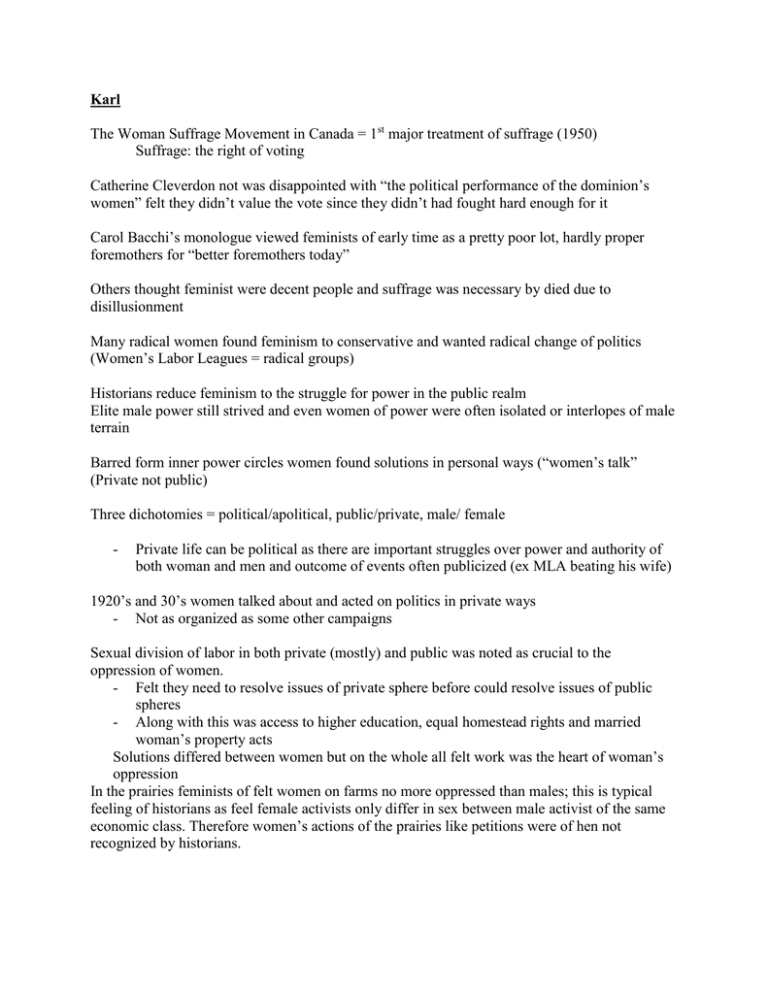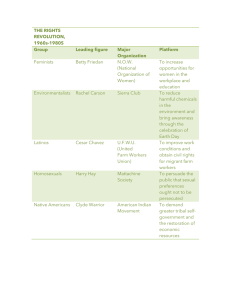Karl The Woman Suffrage Movement in Canada = 1
advertisement

Karl The Woman Suffrage Movement in Canada = 1st major treatment of suffrage (1950) Suffrage: the right of voting Catherine Cleverdon not was disappointed with “the political performance of the dominion’s women” felt they didn’t value the vote since they didn’t had fought hard enough for it Carol Bacchi’s monologue viewed feminists of early time as a pretty poor lot, hardly proper foremothers for “better foremothers today” Others thought feminist were decent people and suffrage was necessary by died due to disillusionment Many radical women found feminism to conservative and wanted radical change of politics (Women’s Labor Leagues = radical groups) Historians reduce feminism to the struggle for power in the public realm Elite male power still strived and even women of power were often isolated or interlopes of male terrain Barred form inner power circles women found solutions in personal ways (“women’s talk” (Private not public) Three dichotomies = political/apolitical, public/private, male/ female - Private life can be political as there are important struggles over power and authority of both woman and men and outcome of events often publicized (ex MLA beating his wife) 1920’s and 30’s women talked about and acted on politics in private ways - Not as organized as some other campaigns Sexual division of labor in both private (mostly) and public was noted as crucial to the oppression of women. - Felt they need to resolve issues of private sphere before could resolve issues of public spheres - Along with this was access to higher education, equal homestead rights and married woman’s property acts Solutions differed between women but on the whole all felt work was the heart of woman’s oppression In the prairies feminists of felt women on farms no more oppressed than males; this is typical feeling of historians as feel female activists only differ in sex between male activist of the same economic class. Therefore women’s actions of the prairies like petitions were of hen not recognized by historians. The feminist cause on the prairies was first carried in town and country by the Women’s Christian Temperance Union. Was more than the conservative agent of social control, as it was often perceived. - Represented and organized power of women opposed to violence against women - This group gave support to women, which in the end allowed women like Louise Mckinney (1917) and Nellie McClung (1921) to both be elected to the Non-Partisan League to the Alberta house. - Both shared a awareness of the troubles of domestic or workplace violence against women, these women didn’t forget about the predicaments they had in the private sphere once they entered the public sphere in politics. Megan -organized, rural woman shared a feminism rooted in an awareness of the very different realities facesby the sexes and a reccuring lack of consideration by the male farm movement. -feminists -Violet McNaughten -founder of the Sask. Woman Grain Growers -womans editor of the Western Producer (1925-1951) -feminist who distinguished the situation of the sexes -Nelly McClung -Emily Murphy -Irene Parlby -UFA member of Alberta's legislature -criticized the Dower Act (which gave only limited property rights to wives because their work was of no economic value. Produce raised by their own labor could not be sold and claimed as their own) . -criticism was not limited to the elite woman like those mentioned. -females wrote to the Grain Growers Guide, the Western Producer, and the Free Press Prairie Farmer during the interwar years. -much of the 20's and 30's was taken up by essentially feminist attempts to win acknowledgement of womans labor and a greater degree of female autonomy. -this campaign was waged over a large front -the campaigner's can be generally identified as two types 1)those who concentrated on charting the extent of woman's labour in order to raise female and public conciousness. 2)those who proposed ways of lightening the heavy weight of toil. -to them, woman's freedom of action was inextricably tied to their situation as workers. -most of their attention was focused on farm homes, but feminists were also determined to defend married woman's right to paid employment (more pertaining to city conditions) -after WW1 the Country Life Movement began. -farm advocates endeavoured to revitalize rural living -to woman, this required a major rethinking of their role (importance) -feminists were concious of the need to document unambiquiusly the extent of womans contribution to the home. -several surveys were conducted: -Woman's section of the United Farmers of Manitba conducted a survey of conditions of 48 farm homes (1920), and then 307 homes (1922). -Woman Grain Grower's of Sask. (1923) sent a questionarre documenting the problems of the rural housewife. -1927- a research committee was established at a conference on Womans Work held ot the U of Sask. -Violet McNaughton joined -she directed the committee to the study of labor-saving devices, water supplies, waste disposal, ventilation, humidification, insulation, electrification, and power. -they hoped to counter the practice of spending money first and almost exclusively on making male farmer's work more productive and ignoring female farm labor. -rural survey conducted by the United Farm Woman of Manitoba (1922) -307 farms surveyed -176 lacked a kitchen water system -only 37 had baths -5 had gasoline irons, 5 had electric irons -only 1 had a mangle -2 had bread mixers -2 had vaccuum cleaners -2/3 cleaned stoves, carried in wood, and took out ashes; 1/3 had furnaces -21 farms had electricity; 243 made due with coal lamps -most had cellars, not basements -only 15 woman did not sew -25% performed no outside chores; 50% milked and 45% assumed responsibility for gardening, poultry, and generalized outside jobs. -the majority also laundered and sometimes mended for hired men -only 15 woman employed year-round domestic help. -these surveys brought female labour to the public's attention -correspondant debates through journals and magazines on issues such as child care, birth control, abusive husbands, and housewrok provided one measure of the degree to which feminist concerns have engaged the minds and the hearts of woman who were normally far from the public eye. -press presentation of these issues during the interwar period documents both the persistant and often unself-concious feminism of readers and the magnitude of the problem of confronting those who wished to listen. Peter Housework - Food preparation along with preserving and cleaning was the most time consuming - 1920’s women in newly settled areas lived in near-primitive conditions - Advertisements of “better ways” gave women a sense of optimism The Combine Helped in the Kitchen? - “The combine is surely a great invention. No more big supplies of food… no more getting up at 3:30 in the morning to prepare breakfast for 15-20 hungry men.” - With the combine there was fewer people to feed and they worked shorter days Dirty Thirties - Due to the poor circumstances women did their best to substitute their labour for goods and services - “Drink your own water and milk, let the grocer keep his tea … Take your own wheat to the mill… Can your vegetables and fruit…” - This extra effort put in by the women made them belief they were doing more than their share and didn’t have to be defensive before antifeminist critics. Child-Care - Lots of advice from “professionals” - Not everyone listened to the advice because the farm women were in no position to implement it. - Houses were small - Bad weather kept them indoors for long stretches - Due to isolation many women placed lots of emotional energy into their children because they could make life bearable Birth Control - Promotion of new child rearing tactics and technology led to the discussion of birth control - When the number and spacing of births couldn’t be controlled, farm mothers couldn’t live up to their high standards - “The unlucky… went ‘through pregnancy regularly every year since I was married’” - Some women who had regular menstrual cycles, with the assistance of their husbands, tried to accommodate pregnancy to seasonal work schedules and personal ambitions. Adult Care - Care of adults (spouses, hired help, etc) required attention for everything to function effectively - Daughters helped with the household chores - Sometimes hired help carried water or firewood - A helping husband was a blessing - Not all husbands helped and some were abusive, leading to the saying “‘about good husbands, the only good ones… are the dead ones.’” - Divorce was difficult to receive and the usual advice was to find comfort in the children Working Women on the Farm - Paid work was common - Women substituted labour for cash purchases, and switched to paid home-based production - An example of this is the Auto Knitter, where the company promised to buy the knitted pieces made - Farm and Ranch Review discussed “Making Farm Hobbies Pay” - Women took care of the supervision of the milk handling and the washing of the milk equipment to ensure the best dollar for the milk Free Press Prairie Farmer gave information on breeding and care of poultry Examples of income producing endeavors Creation of the Egg and Poultry Pool by the United Farm Women of Alberta in 1923 Appointment of a member of the Women’s section of the Grain Growers as President of the Saskatchewan Egg and Poultry Pool Working Women off the Farm - Some women worked off the farm because they needed the money to survive - They became teachers or housekeepers - Married women were often accused of snatching wages from men and single women so they sold their services cheaper yet - Sometimes this worked out well but other times this was hard on the families due to separation for extended periods Steven Women on the Farm The fact that women worked on farms in the 1930 brought attention to the importance of wives, daughters, and sisters The ability for women to “make do” with what they had brought them recognition and respect Letters requesting legal rights of homemakers to living expenses, children, and family property at the death or desertion of husbands gave attention not only to women’s vulnerability, but their claim to justice. Police were often considered as “No Protection” against an abusive husband Wives and mothers were not immune to demands for substantial improvements in the situation of their sex Women writing letters “He has a very queer way of showing his love by abusing you. I wish I were closer tonight so I could throw a scarf over my shoulders and run in and have a chat with you.” A letter to a woman’s page addressing a previous contributor with a bad husband. Women turned to mutual encouragement and support. They wrote letters to each other in published form, giving advice and contributing ideas. Women in different classes The practical realities of life helped bind together grassroots and elite women, Violet McNaughton’s responsibility of her aged and difficult father made her especially sympathetic to other women’s dilemmas. For the more radical women, only the overthrow of the capitalist system would suffice Most high-profile women, however, continued to favor reforms. Prairie rural women had special difficulties in attracting domestic help, people in cities had better pay and more comfortable situations. By reminding housewives that servants might well marry sons and neighbors and thus were much like themselves, western feminists acknowledged that the problem was lack of value attached to women’s work in general. What women had to do “If women took themselves seriously, they would think well of those wo did ‘women’s work’”. “It is necessary for farm women to be educated as to the relationship between the farm housekeeper and her hired help.” An alternative to the search for domestic servants was the effort to get other family members (husbands) to take up home responsibilities. “If a man wants his home perfect, let him help to make it so.” Helping out Looking to men for help had to be something of a long shot. Women turned to campaigns for domestic science instruction which directly addressed the question of female labor. “homebuilding, if it is to remain the dominant concern of civilization, must receive proper consideration.” Was stated by an activist when Saskatchewan’s Department of education wanted to cut the director of home economics. At a meeting in U of Saskatchewan “large sums of money had been devoted to the development of agriculture… comparatively little had been done to better conditions in the home itself.” Women had helped out to earn the homes as much as the men had, but in the matter of equipment, while most farms had modern machinery, the inside of the home was 50 to 75 years behind the times. Simply because they never had a chance. A well organized Home Economics Extension Department was staffed and equipped to do research, render efficient service, and to carry on propaganda and educational work. They demanded home economics be made a compulsory or required subject for the issuance of teachers certificates. Cooperative solution Knowledge of modern home economics potentially allowed women to do without additional help, as did the promise of cooperation. Irene Parlby believed that cooperation was best learned in the home and women were its most natural practitioners. Women could end much of the drudgery that beset them by exercising this talent in the community at large. Cooperative laundries and bakeries found special favor, decreasing the amount of heavy labor. A conservative individualism centered on the family, a rival ideology emanating from modern capitalist producers, and the physical reality of women’s isolation in the home undermined every effort to find a cooperative solution to women’s difficulties. Matt Technology -Technology was very key to the role of women at this time. -Feminists were upset that the men’s workload was becoming lighter while the woman’s workload was just as tough. -Women wanted new “high tech” easy of doing everyday tasks much like men had in the fields. What resulted -Canadian General Electric first wanted to introduce household appliances in an attempt to increase power consumption -1930 – Adopted the “line” approach to the sale of appliances and in the depths of the depression was taking the “General Electric kitchen” across Canada in an aggressive sales campaign. Marketing tactics -Very important because of the following reasons -many women were afraid of machines and did not want to use them -late electrification of rural areas -the usual cash shortages of farmers -the way they marketed these items was totally dependant on success. Poor marketing techniques meant low sales for those reasons. -The female grain growers pointed out that “running water is just as essential as an up to date machine is on the efficiently equipped farm” -They complained that men’s jobs were easier as technology increased, but women’s jobs were not becoming advanced technologically speaking. Birth Control -Women always had one more burden, childbirth. -When the depression struck, there was not enough food or income for more people to live -There were laws that banned birth control and Violet McNaughton spoke out to abolish the law so that women had a choice to have more children. Women and property -Women pushed for rights to be included in owning land, receiving goods from the land, and after divorce, owning land and receiving food and money from the former spouse. Divorce legislation -Gave men preference in proceedings, which caused a lot of controversy. -Women wanted financial support for destitute widows and deserted wives, which was part and parcel of the same effort to gain recognition of women’s contribution.

